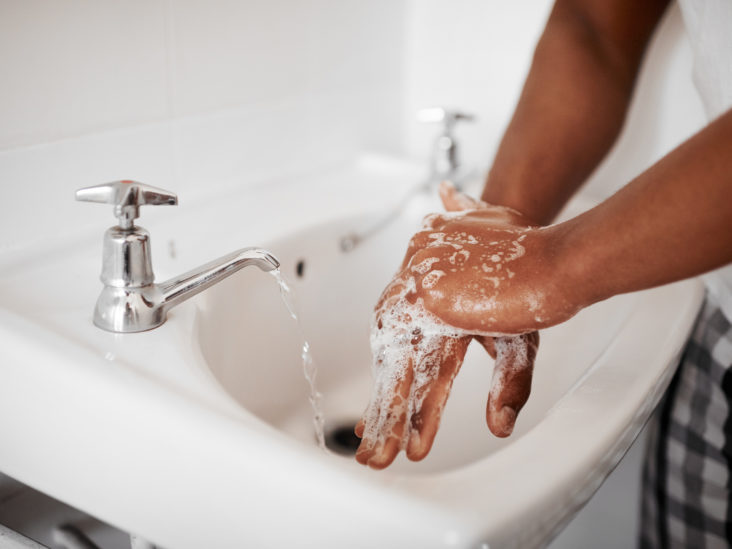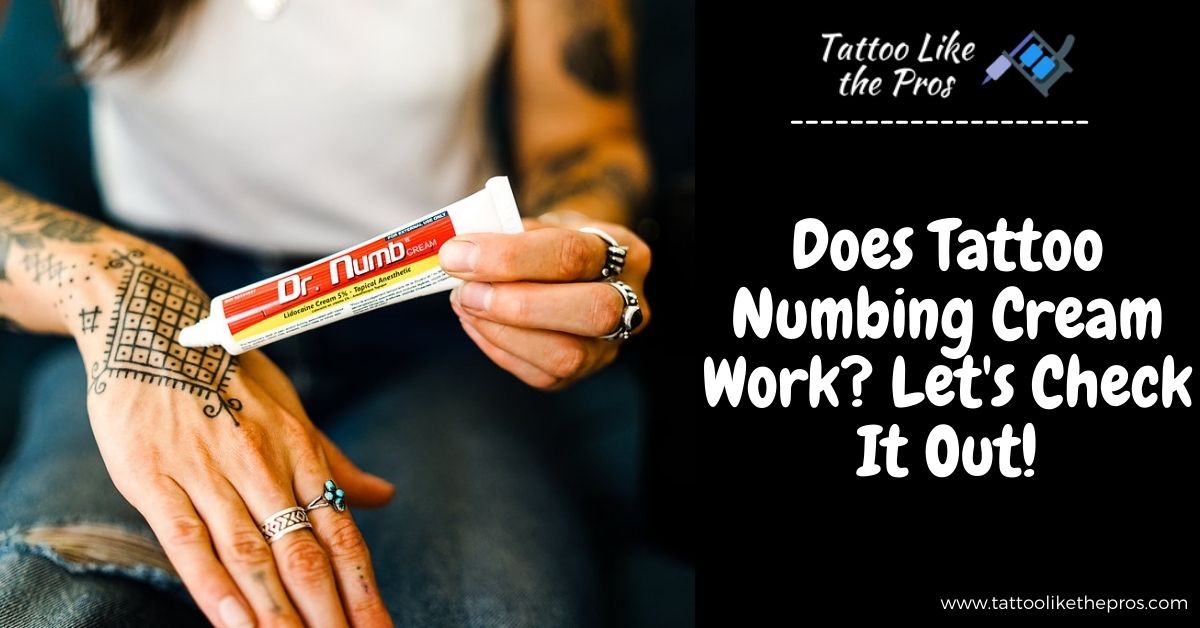Getting a tattoo doesn’t come pain-free. Depending on tattoo style and placement, there’s a respective degree of pain associated with the process. So the short but sweet answer to the question, “does tattoo numbing cream work?” to relieve you of that pain is “Yes.” But you may want to accept that answer with a tiny pinch of salt.
Although tattoo numbing creams work wonders for most people, there are exceptions to the rule. Some may even find the relief from the numbing cream negligible or nil instead of entirely satisfactory.
This article gets into the nitty-gritty of the subject, and without delay, we’ll get down to business. Scrolling down the pages, you’ll discover everything you need to know about the effectiveness of tattoo numbing cream and more.
In-depth Low Down On — Does Tattoo Numbing Cream Work?

You should know about the safety, effectiveness, and correct application method before using any product on your skin. We need to stress using the best numbing creams so that most users find success in using them.
The best tattoo numbing creams are safe and effective. They are the go-to step while getting a fresh new tattoo. It’s one of the main ways of ensuring you’ll have a comfortable inking session.
It would help if you remembered that the pain level might be low to extremely high, depending on the specific tattoo placement. Therefore, it’s a wise idea to get down to making the arrangements to optimize your comfort early on so that you are ready on the day of your sessions.
For numbing the pain, the maximum lidocaine allowed in over-the-counter anesthetics is 5% — a limit set by the FDA. So, if it’s a large, dense tattoo or one on bony body placement, the tattoo numbing cream would work better if it has that level maximum permissible level of lidocaine.
Before jumping the gun with any product per se, as a precautionary measure, you should always discuss the product’s ingredients with your tattooist or dermatologist so that things happen in conformity with your skin type.
Also, it is essential and highly recommended to read and follow the complete instructions given on the product’s packaging for best results. Numbing creams have to be applied shortly before the tattoo session begins. So, it may well be a process you need to undertake on your own after having a prior discussion with your artist or specialist and going through the instructions thoroughly.
Another thing to keep in view is the quantity of the numbing cream. Do you have enough for your tattoo? If you’re about to get a large fullback tattoo, for instance, you should ensure yourself not to fall short of numbing cream supply during its critical application time before the tattooing session.
Here’s What You Need To Know
When applying a tattoo numbing cream, you need to know why, how, and when these creams work the way they do. As you go through the following sections that address those common questions, you’ll also learn about the necessity, pain relief, and any potential risks associated with tattoo numbing creams.
Why Do You Need A Tattoo Numbing Cream?

The premise the above question is based on is whether numbing creams are necessary for you — Is the use out of personal preference or an actual necessity?
Many tattoo artists and enthusiasts in general, for instance, don’t buy the whole concept of numbing creams for the process. Instead, their reasons boil down to their understanding that tattoo pain is a part of tradition (a ritual) or that numbing cream doesn’t work. So, if you’re one of those people, the pain might well be part of the experience you’re looking for — that perhaps adds further meaningfulness.
Generally, there’s nervousness and fear associated with getting your first tattoo. That’s when most folks about to go under the needle will opt for the numbing cream or spray.
You may also prefer the numbing cream if your pain threshold is low. This fact could be due to one or a combination of reasons. Amongst the reasons are injury, genetics, an underlying medical condition (for example, diabetes), chronic pain (that has led to hypersensitization), stress, sleep deprivation, etc.
If your biological or psychological traits cause your low pain threshold, techniques like meditation and relaxation may help you bear the physical pain associated with getting tattooed. All in all, topical anesthetics such as tattoo numbing creams greatly help make the sensations more tolerable.
How Exactly Does Tattoo Numbing Cream Work

A tattoo numbing cream should be applied to your skin before walking into the tattoo studio to get inked. How the cream does its job is determined by the specific active ingredient in the product.
The active ingredients include numbing agents meant to lower your tattoo pain.
No matter which tattoo numbing cream you decide to use, the numbing agents within the cream will fall into one of three categories detailed below. Each of the three categories of numbing agents has benefits and potential risks.
Nerve Deadeners
In the most popular tattoo numbing creams, the chemical ‘lidocaine’ is present as an ingredient, an example of the numbing agents’ nerve deadeners.’ Lidocaine deadens the nerves in the skin temporarily to prevent them from picking up pain signals.
The potential drawback of nerve deadeners is that they seldom sink beneath the skin’s surface. Instead, they merely end up numbing the surface of the skin. That means, even after applying the numbing cream, you’ll still feel some pain. That’s because a tattoo needle goes in approximately 1/16″ beneath the skin’s surface, puncturing into the upper dermis layer. Because of that, to get 100% pain relief, a nerve blocker (vasoconstrictor) would have to be clubbed with the Zone 1 (i.e., 5% lidocaine) of the nerve deadening mixture.
Bonus Read: 18 Most Painful Places to Get a Tattoo on Your Body
Finally, lidocaine’s effects wear off in a relatively short time. To be precise, the effect wears off after about an hour or two of application. That means, if your tattoo work is dense or large, you may need to apply the cream multiple times throughout the session. Be careful as overapplying with a tattoo numbing cream can lead to harmful consequences to your health.
Nerve Blockers
Examples of nerve blockers include tetracaine and benzocaine. Like most nerve blockers, both tetracaine and benzocaine are pH-neutral. However, nerve blockers have a different effect compared to nerve deadeners.
For a more wholesome numbing effect, often, nerve blockers have to be combined with nerve deadeners. This combination helps in preventing flinching involuntarily.
Nerve blockers alone won’t numb you 100%. Although, they’re effective in reducing the intensity of the pain that’s felt. Excessive application of nerve blockers may lead to harmful consequences to your health.
Vasoconstrictors
Among all three classes of numbing agents, vasoconstrictors are the most powerful and potentially dangerous. Vasoconstrictors include epinephrine, which means they work by constricting the blood vessels. This way, both swelling, and bleeding are reduced at the spot you’re getting inked. In addition, the effect of vasoconstrictors can last longer by slowing their absorption rate by combining them with other anesthetic chemicals.
Ideally, vasoconstrictors combined with nerve blockers and deadeners lead to a longer-lasting topical anesthetic solution.
There are serious, potential health risks associated with blood vessel constriction that you shouldn’t overlook. The threat could lead to ischemia — constricting oxygen in bodily tissue. The cause can be tachycardia, which is a dangerously fast heart rate.
Any numbing cream you select will contain certain ingredients and preservatives that may lead to an allergic reaction. Therefore, you should go through the ingredients before purchasing, especially if you have sensitive skin. People with sensitive skin are usually better off applying creams closest to being all-natural with minimal additives.
Always consult your medical practitioner prior to choosing a numbing agent. They would review your medical history and guide you towards the correct and safe anesthetic for you.
Also Read:- Tattoo Prices: How Much Will I Pay?
The Best Way To Use A Tattoo Numbing Cream
Using your numbing cream correctly is the best way forward. Of course, you should always follow the instructions enclosed with the product packaging. More importantly, your doctor’s advice and your tattooist’s consultation should together yield an accurate consensus on which cream is best for your skin and general health.
That said, here are the best steps to follow to get effective results:
Step 1: Select The Right Numbing Cream For Yourself

Take your artist and doctor’s advice and get the ingredients verified by them so that there is no clash with your medical history. Also, the effectiveness depends on the type of tattoo. For example, if you’re about to have a long session, and the numbing cream doesn’t contain epinephrine, you may end up with it wearing off halfway into the tattoo session.
Step 2: Sanitize And Clean The Skin Using Green Soap

This step will take care of any dead or oily skin. Though green soap does contain negligible alcohol content, which can lead to a minor acidic response or marginally slow down the effectiveness of the numbing agent you’ll apply after the washing. Next, you should pat dry the skin with a paper towel.
Step 3: Apply The Numbing Cream (The Pre-Deadener)

Much like the above two steps, step 3 is also doable at home before heading to the tattoo parlor for the session. Once the pre-deadener is applied, you’ll have to wait for the area to become numb. You should apply a 1mm layer on your skin and leave it applied anywhere from 10 to 30 minutes, depending on the skin type and the numbing cream used. If the area you’ve applied the cream to is a relatively thicker skin area, the time could be closer to 30 minutes. If the skin there is thin, the time to numb would be accordingly less. Note, under no circumstances should you ever leave your numbing cream on for over an hour.
Step 4: Wash Off The Numbing Cream (The Pre-Deadener) And Begin The Tattoo Session

Step 4 is the second last step in using the numbing cream. This step, too, is essential for the tattoo numbing cream to work optimally like all other steps. Once the skin is numb, it is numb. There is no need for the remnants of the pre-deadener to remain on your skin while getting inked. This step happens at the tattoo studio, and your glove-wearing artist will do it before applying the tattoo stencil. Your artist may use a damp cloth for this step.
Step 5: Apply A Recommended Numbing Spray Periodically During The Tattoo Session

During long sessions, often in excess of an hour, the tattoo numbing spray should be used every 20 minutes or so. The spray should contain a vasoconstrictor so that the skin can be kept numb during the entire tattoo session.
You May Also Read: Can You Put Vaseline on Your Tattoo? Complete Guide
Conclusion
Body art doesn’t have to be as painful. Since the answer to the question — Does tattoo numbing cream work? — is a positive response; you should apply numbing cream before getting inked. It’s essential to wear gloves while applying the layer of numbing cream so that you don’t end up numbing your fingers. Similarly, the artist should wear gloves while wiping the cream off with a damp cloth moments before beginning the session.
